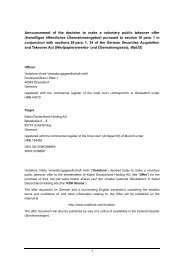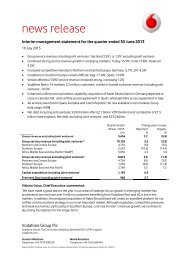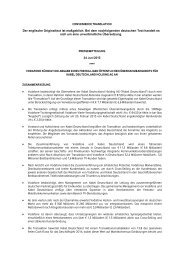Create successful ePaper yourself
Turn your PDF publications into a flip-book with our unique Google optimized e-Paper software.
Moving the debate forward • The Policy Paper Series • Number 8 • April 2008<br />
Table 1: Examples of introduction of on-net price differentiation<br />
by established operators<br />
Incumbent Launch of<br />
on-net pricing new network<br />
Germany Jul-95 (T-Mobile) May-94 (E-Plus)<br />
Norway Oct-95 (Telenor) Sep-93 (NetCom)<br />
France Jul-97 (SFR) Jan-96 (Bouygues)<br />
Ireland Jun-99 (Eircell) Mar-97 (Digicell)<br />
Italy Mar-00 (TIM) Mar-99 (Wind)<br />
Spain May-99 (Movistar) Jan-99 (Amena)<br />
Source: Teligen & GSM Association<br />
The exceptions to the above are Portugal, Sweden and the<br />
UK, where on-net pricing was introduced at a time not directly<br />
related to the launch of a new network.<br />
Particulars of individual countries are described below:<br />
• In Germany, T-Mobile appears to have introduced on-net<br />
pricing in 1995, before Mannesmann (<strong>Vodafone</strong>) which<br />
followed in 1996. The moves by both these operators<br />
followed soon after the launch of E-Plus in 1994.<br />
Unfortunately our data does not allow us to ascertain<br />
whether or not E-Plus launched with on-net price discounts,<br />
but E-Plus certainly had large on-net discounts by the time<br />
our E-Plus data begins in 1999.<br />
• In Norway on-net pricing first appears with Telenor in<br />
1995. This would have been at a time when the GSM<br />
network was taking over for the “old” NMT network,<br />
and competition between Telenor and Netcom (which<br />
launched in 1993) was heating up.<br />
• Similarly, in Portugal, TMN was facing increasing<br />
competition from Telecel (<strong>Vodafone</strong>) in the early 1990’s,<br />
and introduced a differentiated pricing in 1995. Telecel<br />
data for the same period is unfortunately not available.<br />
• For France the available data does suggest that SFR came<br />
first with on-net pricing in July 1997, and that Itineris<br />
(Orange) followed in December 1997. Both these moves<br />
followed the launch of Bouygues in 1996. Unfortunately<br />
our data does not allow us to ascertain whether or not<br />
Bouygues launched with on-net price discounts, but<br />
Bouygues certainly had large on-net discounts by the time<br />
our Bouygues data begins in 2000. Unusually, Orange’s<br />
on-net discounts remained at a fixed 25% until June<br />
2001, when it was withdrawn altogether, despite on-net<br />
discounting being continued by the smaller rivals.<br />
• In the UK both One2One and <strong>Vodafone</strong> had on-net<br />
pricing differentiation when out data series begin in 1997.<br />
Cellnet (now O2), however, introduced on-net pricing as<br />
late as in 2000.<br />
• In Ireland, Eircell introduced on-net prices in May 1999. 1<br />
This followed the launch of Esat in 1997. Unfortunately<br />
our data does not allow us to ascertain whether or not Esat<br />
launched with on-net price discounts, but Esat certainly<br />
had large on-net discounts by the time our Esat data<br />
begins in 2000. Notably Esat’s discounts, compared to<br />
On-net Pricing in Mobile<br />
those of Eircell, were both larger and often of wider scope<br />
(i.e. applying to all calls).<br />
• In Spain it is likely that on-net price discounts first<br />
appeared with Movistar in May 1999 (following Amena’s<br />
market entry earlier in 1999). <strong>Vodafone</strong> had on-net<br />
discounts with the first available data from July 2000.<br />
• In Italy, Telecom Italia Mobile (TIM) appears to have<br />
introduced on-net pricing in March 2000 (following Wind’s<br />
entry to the market in 1999). The range of price differences<br />
has remained largely unchanged over the 10 year period.<br />
• In Sweden the on-net pricing was introduced by Telia in<br />
2000. The competitive environment with Telia and Tele2<br />
had then existed since 1992.<br />
The data shows that on-net pricing was introduced as a<br />
competitive instrument resulting from growing competition<br />
in the mid 1990’s. Once introduced by one operator, other<br />
operators in the same market(s) were quick to follow suit,<br />
and by the end of the 1990’s virtually all operators had<br />
differentiated pricing for on-net and off-net calls.<br />
Since the year 2000, although there have been numerous<br />
changes to individual operator pricing packages, on-net<br />
price discounts have remained a key feature of the market,<br />
at roughly the same overall range of discounts (see Appendix<br />
B for details). One exception to this is France where on-net<br />
discounts have not been used by the network operators<br />
since 2005.<br />
3. Conclusions<br />
On-net pricing differentiation was introduced in most markets<br />
at the time of more heated competition. Once introduced, it<br />
became a regular feature of most tariffs in the market.<br />
The size of the market does not appear to have been a<br />
determining factor, but the competitiveness of the market<br />
probably was important. In 1995 the markets in Germany<br />
and Portugal were both highly competitive with second<br />
and (in Germany) third new entrant operators challenging<br />
the ex-incumbent operators. In other markets that<br />
followed, on-net pricing followed intensified competition<br />
by new entrants.<br />
Once on the market it is clear that most other operators<br />
adopted the principle of differentiated pricing for different<br />
destination networks.<br />
However, in more recent years some network operators<br />
have made a point of going the opposite way, (re)introducing<br />
uniform pricing regardless of destination network in the<br />
market (country). Examples are the three network operators<br />
in France, and Netcom in Norway.<br />
27

















